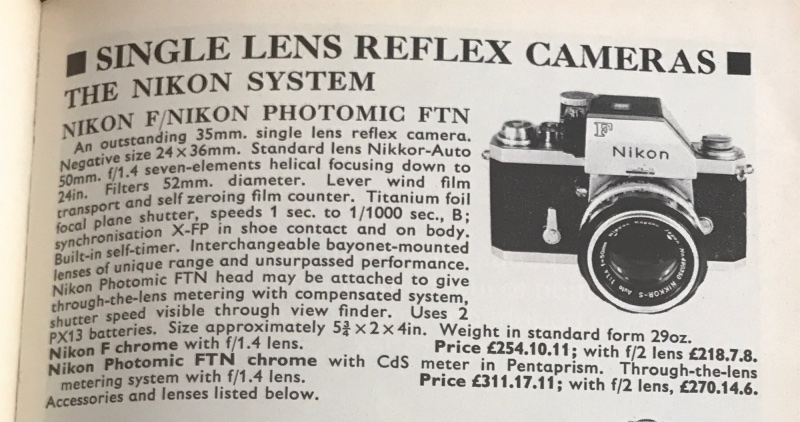More capability, same price.
I happen to still have my copies of the Wallace Heaton ‘Blue Book’ gear catalogs from the 1960s. These were published annually by the bespoke supplier of gear to HM QE2, the firm going bankrupt a few years later when they failed to see discounted high street retail coming. They remain an interesting historical artifact, or artefact if you speak the Queen’s English.
Here is the listing for the best 35mm film SLR of the time – I would argue it was the best film SLR of all time – the Nikon F. This is from the 1969 Blue Book, 50 years ago:

Nikon F in 1969
With the clunky Photomic FTN metering head the Nikon F retailed for £270.73 (converted to decimal from pounds, shilling and pence – long live the Empire).
Going to the US Bureau of Labor Statistics web site for the history of the Consumer Price Index and to the Bank of England site for the exchange rate of the pound sterling against the US dollar (yes, it’s been downhill those 50 years) the multiplier for the 1969 price converted to 2019 US dollars comes to 15.4. So that £270.73 of 1969 is $4,170 today.
Looking at the current price for the top of the line Nikon DSLR today, the D5, discloses a retail price of $6,500 for the body and $200 for the 50mm f/1.8G standard lens, a total of $6,700. For the like-equipped D850 the total comes to $3,200 and the Z7 comes to $3,150.
Now capabilities of the 1969 and 2019 gear are not easily compared other than to say that the modern digital body and lens are superior in every way – speed, reliability, ISO range, storage capacity and so on. The 1969 Nikon F falls in the middle of the price range of the (arguably overpriced) D5 and the extremely capable D850. Indeed, common sense probably dictates the choice of two D850s over one D5 at the same price. The overall price change, inflation adjusted, has not changed at all. But the capabilities of the modern hardware are two orders of magnitude removed from that of the 50 year old predecessor.